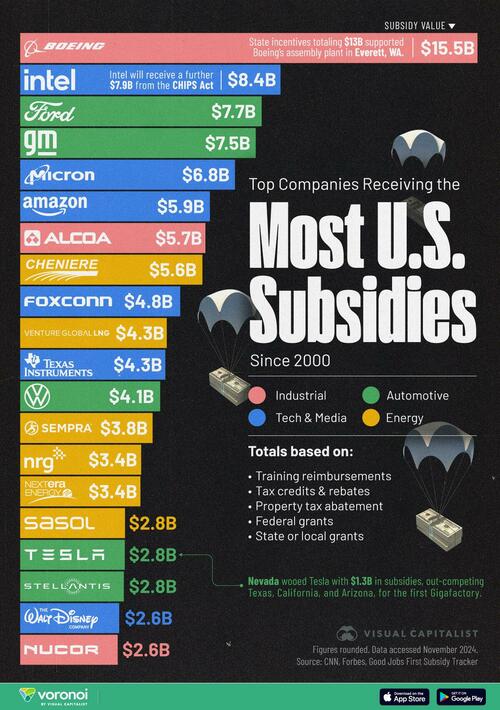Which US Companies Receive The Most Government Subsidies?
This chart, via Visual Capitalist’s Pallavi Rao, ranks the companies which have received the most American taxpayer support (in the form of government subsidies) since the year 2000.
Government subsidies take a variety of forms: tax credits, abatements, training reimbursements and direct grants.
Data is sourced from D.C.-based non-profit Good Jobs First’s subsidy tracking database, accessed November 2024.
Ranked: Companies Receiving the Most Government Subsidies
Over the last quarter of a century Boeing has received nearly $16 billion in government subsidies, putting it at the top of this list.
| Rank | Company | Industry | Subsidy Value (2000–2024) |
|---|---|---|---|
| 1 | Boeing | Industrial | $15.5B |
| 2 | Intel | Tech & Media | $8.4B |
| 3 | Ford Motor | Automotive | $7.7B |
| 4 | General Motors | Automotive | $7.5B |
| 5 | Micron Technology | Tech & Media | $6.8B |
| 6 | Amazon | Tech & Media | $5.9B |
| 7 | Alcoa | Industrial | $5.7B |
| 8 | Cheniere Energy | Energy | $5.6B |
| 9 | Foxconn Technology Group | Tech & Media | $4.8B |
| 10 | Venture Global LNG | Energy | $4.3B |
| 11 | Texas Instruments | Tech & Media | $4.3B |
| 12 | Volkswagen | Automotive | $4.1B |
| 13 | Sempra Energy | Energy | $3.8B |
| 14 | NRG Energy | Energy | $3.4B |
| 15 | NextEra Energy | Energy | $3.4B |
| 16 | Sasol | Energy | $2.8B |
| 17 | Tesla | Automotive | $2.8B |
| 18 | Stellantis | Automotive | $2.8B |
| 19 | Walt Disney | Tech & Media | $2.6B |
| 20 | Nucor | Industrial | $2.6B |
Most of the subsidies have come from Washington State, which has nine preferential tax rates that benefit the aerospace industry.
Boeing has an assembly plant in the city of Everett—reportedly the largest manufacturing facility in the world—where it makes the 747, 767, 777, and the 787 airplanes.
There’s more to this Boeing story—but we cover that in the next section.
Ranked second, Intel’s received more than $8 billion from the government since 2000.
But this doesn’t include some critical CHIPS Act funding that’s just been greenlit for the company. Another $7.9 billion is on the way from the Biden Administration that’s keen to secure the American semiconductor supply chain.
For context, Intel both designs and manufactures chips (unlike say, Nvidia and Apple) but its foundry business has been in trouble for a while, leading to job cuts and restructuring.
This new federal lifeline comes with a caveat: no stock buybacks.
Why Boeing Bid Adieu to Bonanza Tax Breaks
Back to Boeing for a bit.
In 2020 Boeing asked Washington State to repeal one specific tax break (worth roughly $100 million a year) to avoid paying tariffs when selling its planes to European airlines.
Why would it have to pay tariffs? This involves a bit of backstory for a Boeing-Airbus tiff that’s been ongoing for the last decade and a half, backed by respective governments.
In 2004, the U.S. complained against Airbus receiving “illegal government launch aid” which helped Airbus take away market share from Boeing. A year after that, the EU complained against Boeing’s tax subsidies—specifically naming Everett’s support to the Boeing facility.
By 2020, the WTO ruled on both cases, handing out tariffs to each manufacturer’s exports to the other market.
Mindful of that WTO ruling, Boeing asked Washington State’s tax break to be repealed and in 2021 moved production of the 787 Dreamliner to South Carolina.
Nevertheless the plane manufacturer reported receiving $86 million in tax incentives in 2022.
How’s the semiconductor market looking after the three years of the AI revolution? Check out Ranked: Semiconductor Companies by Industry Revenue Share to see who’s on the up and up.
Tyler Durden
Fri, 12/20/2024 – 05:45


